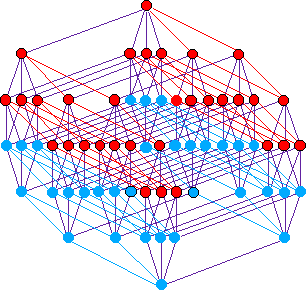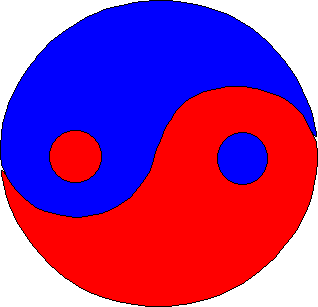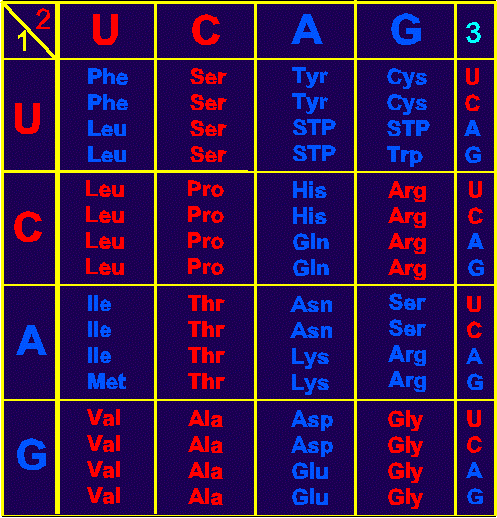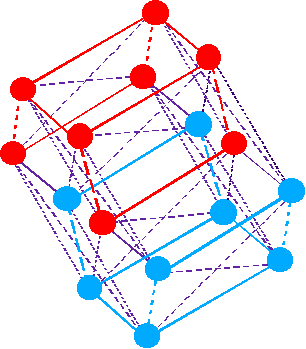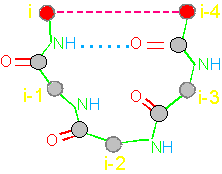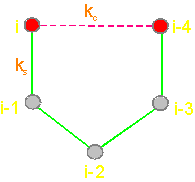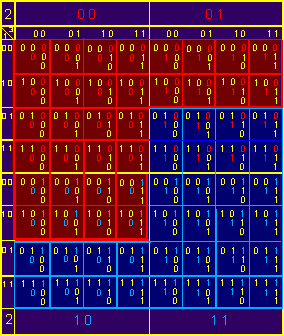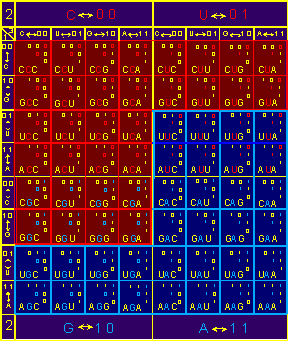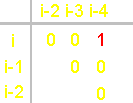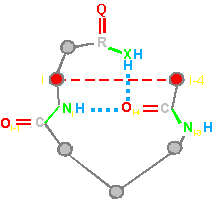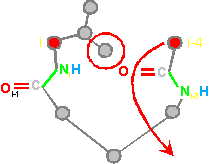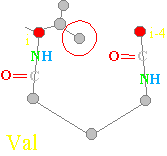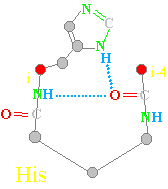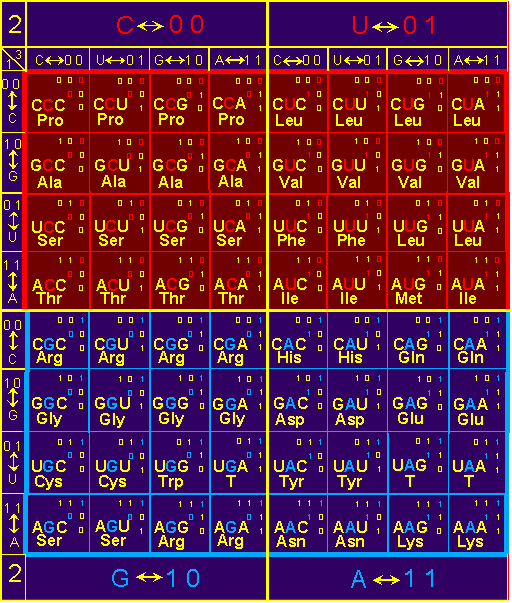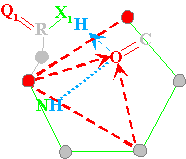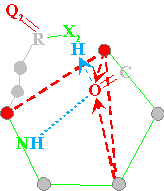|
PRINCIPLES OF TOPOLOGICAL GENETIC CODE Personal
page number 1 Karasev Vladimir Aleksandrovich |
|
|
Key words: genetic code, the spatial structure of the doublet and triplet genetic code,
proteins, amino acids as physical operators, protein pentafragments,
the nature of the triplet-amino acid assignment, the topological bases of the
genetic code |
|
|
Book V. Karasev “Genetic Code:
New Horizons"
Book V. Karasev and V. Luchinin "Introduction to the design of bionical
nanosystems"
Book V. Karasev «Principles of topological coding of chain polymers and
protein structure»New
Sites V. Karasev: Spatial structure of the canonical set of amino acids http://amino-acids-20.narod.ru/index_e.htm Molecular
vector machine of proteins http://vector-machine.narod.ru/index_e.htm Aid to the
atheist: A new theory explaining essence and origin
of life http://ateistu.narod.ru/english.htm «Protein 3D
- visualizer of supramolecular biostructures»New |
Welcome! I invite you to scientific voyage to the world of the Genetic code. I
must warn you that it will be hard job and will require from you some
intellectual efforts. However, like climbers, who have the reached top,
receive incomparable pleasure, you too, having looked through the homepage,
will see the world of beauty and original aesthetics, which is connected with
the Genetic code. This page is an
updated version. Previous version was created about ten years ago and some
out of date. Three groups of researchers, as far as we know, have come almost
simultaneously and independently to the idea of the spatial
structure of the genetic code: H.H. Clamp from South Africa [1], M.A. Jimenez - Montaño and his colleagues from Mexico [2,3] and we, V.A. Karasev and S.S. Sorokin from Russia [4]. A little later the
Russian researcher S.V. Petoukhov [5] has come to this
idea too. Each of them offered his own version of this structure, and each
has come to this idea his
own way. Visitors can get acquainted with these matters in [6-8]. Over years past from the appearance time of this
works many questions have made
significant progress in development. There was a special literature
on the spatial structure of the
genetic code, which was the subject of an analytical review [9]. Our page describes
the version of the structure of the genetic code and its interpretation of
nature, to which we have come. There is a site, M.A. Jimenez - Montaño, which gives a 'live' presentation of his
version of the spatial structure of the genetic code by using special
software (http://www.uv.mx/ajimenez/Manual/HGCodeContent.htm). There are probably
other sites devoted to this issue. We are not inclined to discuss here, whose
path is more promising and correct. Time will tell and put everything to its place. Most
contemporary literature on the genetic code [9] suggests that not all
problems of the genetic code have
been fully resolved. You will
get acquainted with what has
become known. So in a way. Address for connection: genetic-code@narod.ru |
1. Modern table of the genetic code
|
|
Modern genetic code table sets the assignment
of triplets to certain amino acids, but does not reflect its real structure.
2. The spatial structure of the genetic code
|
2.2. Doublet genetic code |
||
|
|
|
|
Results:
1. Based on the principle of complementarity a two-dimensional
structure of the doublet code, having the symmetry, was built.
2. Using the
principle of single transitions
between the bases in doublet and triplet genetic
code, spatial structures of doublet
and triplet genetic code, isomorphic,
respectively, to the Boolean hypercubes B4
and B6 were built.
3. Topological basis of the genetic code
|
3.3. Supermatrix
transformation into triplet topological code |
|||
|
Protein pentafragment
|
4-arc chain graph |
|
|
|
Matrix for the description of bonds |
|||
Results:
1. The notion of an
elementary fragment of the protein, consisting of four links (a fragment of
five amino acids - pentafragments) and its analogue -
4-arc graph described by triangular matrices of six variables taking values 0
and 1, was introduced.
2.
On the basis of 64
triangular matrices the Supermatrix consisting of 4
blocks, describing all the conformations of 4-arc
graph and pentafragments of protein was constructed.
3.
By
assignment to the
three pairs of variables first letters
of names of the nitrogenous bases
(00 <--->
C, 01 <--->
U, 10 <---> G, 11 <---> A) triangular matrices
are transformed to triplets, and
the Supermatrix itself is transformed into a triplet genetic code.
Thereby it is shown, that
in the basis of a genetic code the encoded by means of triplets
conformations description
of protein and its analogue - 4-arc chain graph lays.
Spatial structure for the Supermatrix is hypercube B6. Hence the answer to the question why the spatial structure of the triplet genetic code, obtained by other means,
proved to be isomorphic to the Boolean
hypercube В6.
|
|
|
|
|
||
|
connectivity |
anti-connectivity |
Non polar amino acids – operators of anti-connectivity |
Polar amino acids – operators of connectivity |
||
|
Physical operators |
|||||
|
4.3.
Assignment of amino acids side chains to blocks of a genetic code triplets |
|||||
|
Operators of anti-connectivity |
---> |
|
|
|
|
|
Operators of connectivity |
---> |
||||
Results:
1.
Concepts of physical
operators of connectivity and anti-connectivity of the side chains recreating, respectively,
cyclic and acyclic conformation of the
protein are introduced.
2. It is shown that non-polar amino acid side
chains can be regarded as anti-connectivity
operators, and polar amino acids - the operators of the connectivity.
3.
To
the blocks of triplets coding the acyclic conformations
of the protein (C, U), correspond nonpolar and
weakly polar amino acids (anti-connectivity
operators), and to the blocks of triplets coding the cyclic
conformations (G, U)
– the polar amino acids capable of forming hydrogen bonds.
Thus found a fundamental solution to the problem of triplet - amino acid assignment in
the genetic code: amino
acids correspond to the triplets, which encode the protein conformation,
reconstituted by these amino acids as the physical operators.
4. It is shown that the reconstruction of symmetric conformation of the protein requires different physical operators.
|
In the course of
the analysis it has been revealed, that various side chains (e.g., identical in properties,
but different in length amino acids)
can have different directions of
the applied force (in other
words, different vectors of action).
This was the starting point to
a special analysis of the
physical operators in the area of the main chain bond цепипNiH...Oi-4=C and
resulted in the
development of model of molecular vector machine of proteins.
On the basis
of these representations the highly effective method for predicting of secondary structure of proteins, which has become a patent basis, is
developed. More in detail it is possible to familiarise
with these questions on our site «Molecular vector machine of proteins»:
http://vector-machine.narod.ru/ |
We wish you the further successful scientific
travel!
Address for connection: genetic-code@narod.ru
RThe Work
was carried out at the Centre of Microtechnologies
and Diagnostics (CMID) of the St.-Petersburg State Electrotechnical
University "LETI", at financial support of University
Acknowledgements:
I express my sincere gratitude to A.I. Belyaev for help in editing the English version of this
page.
